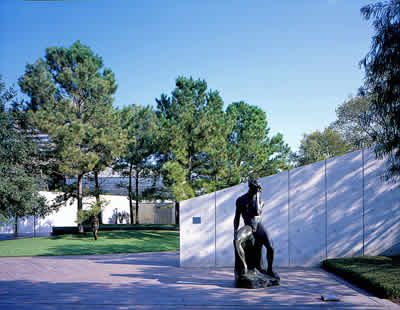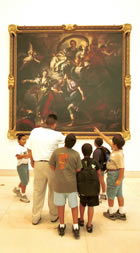 |
 |
 |
|
 |
Praised as the most beautiful acre in Houston, the Litllie and Hugh Roy Cullen Sculpture Garden of the Museum of Fine Arts, Houston houses more than 30 masterworks from the MFAH and other major collections.
|
|
|
Houston Museum Features
Classic, Contemporary Art In a city known for cowboys, sports teams (the good, the bad and, frequently, the very ugly), dripping summer humidity, constant highway construction, and barrels and barrels of oil, you might not expect to find a museum of the caliber of the Museum of Fine Arts, Houston. The Museum is an astonishing and intriguing surprise every trip. For those attending the USITT 2008 Annual Conference & Stage Expo in Houston, it is a quick ride southbound on the light rail ($2 for a roundtrip which can be purchase with a debit card or cash). The light rail is just steps from either conference hotels, and will bring you to the Museum District stop. From there, it is less than a block to the MFAH. On Thursdays there is no admission charge, and the museum is open until 9 p.m. It's still a bargain on any other day at $7 for adults. On Friday, Saturday, and Sunday, the MFAH is open until 7 p.m. (The light rail runs until after midnight and is safe to ride at night.) MFAH is a Mies Van der Rohhe master-planned, multiple building complex so it is challenging to see everything desired on a single trip. Since seeing all will be impossible, choose carefully among the myriad of options. One caveat, though. Make certain to use the underground tunnel when going from the comparatively new Beck Building to the Law Building. The tunnel is actually a piece of art you walk through; disconcerting at times, but very cool and fun. There are the things you would expect to find -- a collection of Of particular note for the MFAH are 19th century American landscape paintings by Thomas Cole, Frederic Church, and others who were swept up in the breathtaking beauty of the newly discovered American wildernesses. Not to be outdone, the civilized American is well represented with works by the incredible John Singer Sargent, the captivating William Merritt Chase, and the intriguing Childe Hassam. (These artists offer a treasure trove of late 19th and early 20th century period details.) Additionally, there are several pivotal pieces from the Ashcan School as well as Georgia O'Keefe and other Taos artists. An exceptional find is the Glassell Collection of African Gold. This collection contains the greatest assemblage of gold objects in the world. The Glassell has gold items that you'd find in a Monty Python skit -- gold pith helmets, gold rifles with cartridges, and a gold-leafed fly whisk (the Akans are most certainly a stylish tribe). Weird and wonderful. The collections that are of importance to both the MFAH and designers are the decorative arts. The only one actually housed in the main MFAH campus is the Art of Design collection. The others are located at Bayou Bend and the Rienzi. The Art of Design collection focuses on modern and contemporary decorative arts with truly fine examples of exceptional design, craftsmanship and originality. The exhibit on display during the USITT 2008 Conference & Stage Expo will be Designed by Architects: Metalwork from the Margo Grant Walsh Collection featuring superb pieces executed in innovative metal materials. An article in a future Sightlines issue will focus on Bayou Bend and the Rienzi, both renowned for their decorative arts collections. As seems to be true with every art museum in Texas, there is a costume collection. Although MFAH's collection can't begin to compare with the one housed at the University of North Texas, it still has some lovely examples mostly worn by fashion-conscious local matrons including garments by Geoffrey Beene, Bill Blass, Oscar de la Renta, Vivienne Westwood, Givenchy, and Yves Saint Laurent. It is rumored that there are some Worths in beautiful condition. Items probably more important in this collection (somewhat more mundane though none-the-less exquisite) are the non-Western textiles and Indian and Indonesian costumes. For those visitors who just can't seem to get there when the Museum is open, there is a spectacular sculpture garden north across Bissonet from the Law Building. The Cullen Garden is a soothing, surprisingly quiet place to contemplate some fantastic sculpture until 10 p.m. or just a great place to sit and consider all the things you have learned at the Conference! |
||
 European Masterworks weighted in Renaissance and Baroque art but running the gamut from Memling to Matthias Stomer's Judgment of Solomon (c. 1640) to typically handsome Joshua Reynolds to the incredible skies and seas of J.M.W. Turner. However, the MFAH has a remarkable collection of Impressionist and Post-Impressionist pieces based on the Beck Collection. Audrey Jones Beck and husband, John, began collecting works that focused on 19th and very early 20th century Paris in the 1960s. Their collection included works by Manet, Pissarro, Matisse, and Seurat. In complement to this collection are pieces donated by others featuring key works by artists such as Renoir, Cezanne, Degas, and Picasso.
European Masterworks weighted in Renaissance and Baroque art but running the gamut from Memling to Matthias Stomer's Judgment of Solomon (c. 1640) to typically handsome Joshua Reynolds to the incredible skies and seas of J.M.W. Turner. However, the MFAH has a remarkable collection of Impressionist and Post-Impressionist pieces based on the Beck Collection. Audrey Jones Beck and husband, John, began collecting works that focused on 19th and very early 20th century Paris in the 1960s. Their collection included works by Manet, Pissarro, Matisse, and Seurat. In complement to this collection are pieces donated by others featuring key works by artists such as Renoir, Cezanne, Degas, and Picasso.